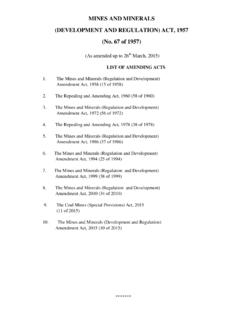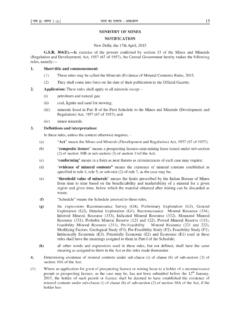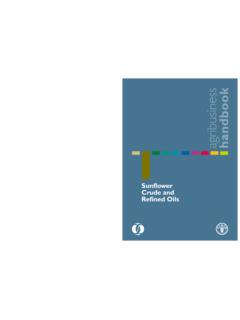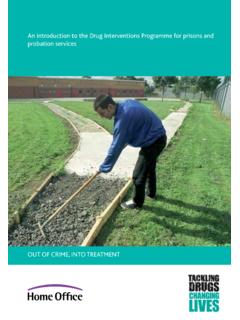Transcription of & 5th July, 2013 at New Delhi. - DGMS
1 1 Recommendations of 11th conference on Safety in Mines held on 4th & 5th july , 2013 at New delhi . COMMITTEE A 1. Review of status of implementation of recommendations of 10th Conference on Safety in Mines. The committee unanimously decided to carry forward the following Para of the recommendations of the 10th Conference on Safety in Mines, namely:- (a) Necessary facilities for monitoring the environmental parameters in respect of Methane and Carbon Monoxide should be provided at mines. Facilities of continuous type monitoring should be installed within two years in all degree III gassy COAL and in such other mines having active underground fire.
2 (b) Indigenous manufacturers should be encouraged to manufacture necessary equipments. (c) Time bound programme is to be made, which should be decided in a tripartite committee at company level. In underground specified mines where long or arduous travel is involved, arrangement for transport of men should be made with a target of 20 % every year. (a) In respect of small-mechanised mines, which are operating in NON-COAL sector, it may not be feasible for a small organization to create a special department on Occupational Health Services.
3 For such small mines, it is suggested that an Association of small mines operators creates common facilities and infrastructure for occupational health services. Creation of such facilities are specially needed for asbestos, manganese and mica mines. Development of a portable instrument for detecting hidden slips in roof of COAL mines should be taken up on priority by R&D organizations. The instrument should be developed by S&T project which should be guided by a committee consisting of an officer from DGMS and others from COAL Industry and Research Organisations.
4 (a) Before the valid gate pass is issued for entry of trucks and other vehicles not belonging to management into the mine, the mine engineer should check the road-worthiness of such vehicles. (b) In order to check entry of un-authorized vehicles in mine premises, each mine should establish property manned check gate(s) at the entrance(s) where record of entry and exist of each such vehicle should be maintained. (a) All persons engaged at any work within the mine premises through the contractors have received relevant training and other job-related briefings and that the drivers of vehicles belonging to contractors entering the mine premises have additionally been explained the salient provisions of "traffic rules".
5 (b) Each mining company should draw up appropriate training schedules and modalities in this regard and implement the same. (c) In case of smaller mines, such arrangement may be made by association of mine operators. 2 Considering the risk of fire, all COAL mine companies shall rank its COAL mines on a uniform scale according to its risk from fire on scientific basis. Guidelines may be framed by DGMS and circulated to all mining companies. Contractor work vis- -vis safety Contractor work safety Employer's responsibilities (a) Suitable clauses (in consistence with risk of the work allotted) shall be included in tender document (including NITs) stating how the risk arising to men and material from the mining operation/operations to be done by the contractors shall be managed.
6 (b) Ensure that contractors are familiar with the relevant parts of the statutes, health and safety management system and are provided with copies of such documents prior to commencing work. (c) Ensure that contractor's arrangements for health and safety management are consistent with those for the mine owner. All the rules, regulations and bye-laws as applicable to the mine owner are also applicable to the contractor. Details of the contractor's workmen should be maintained in the owners Form-B register. Whereas as C, D & E registers for contractor men may be maintained independently by the owner and shall be kept in the mine office of the manager.
7 (d) Ensure that contracts should preferably of longer period (3 years), so that there is adequate scope of management of safety by the contractor. (e) Ensure that contractors provide the machinery, operator and other staff with written safe work procedures for the work to be carried out, stating clearly the risk involved and how it is to be managed. (f) Monitor all activities of the contractors to ensure that contractors are complying with all the requirements of statute and the system related to safety. If found non-compliance of safety laws directing the contractors to take action to comply with the requirements and for non-compliance, the contractor may be suitably penalized.
8 Clause to this affect may be a part of the agreement between the employer and the contractor. (g) Where a risk to health or safety of a person arises because of a non-compliance directing the contractor to cease work until the non- compliance is corrected. Contractor's responsibilities: (a) Prepare written Safe Operating Procedure (SOP) for the work to be carried out, including an assessment of risk, wherever possible and safe methods to deal with it/them. (b) Provide copy of the SOP to the person designated by the mine owner who shall be supervising the contractor's work.
9 (c) Keep an up to date SOP and provide a copy of changes to a person designated by the mine owner (d) Ensure that all work is carried out in accordance with the Statue and SOP and for the purpose he may deploy adequate qualified and competent personnel for the purpose of carrying out the job in a safe manner. (e) For work of a specify scope/nature, develop and provide to the mine owner a site specific Code of Practice (COP). (f) Ensure that all sub-contractors hired by him comply with the same requirement 3 as the contractor himself and shall be liable for ensuring the compliance all safety laws by the sub or sub-sub contractors.
10 (g) All persons deployed by the contractor for working in mine must undergo vocational training, initial medical examination, PME. They should be issued cards stating the name of the contractor and the work and its validity period, indicating status of VT & IME. (h) Every person deployed by the contractor in a mine must wear safety gadgets to be provided by the contractor. If contractor is unable to provide, owner, agent and manager of the mine shall provide the same. (i) The contractor shall submit to DGMS returns indicating -Name of his firm, Registration number, Name and address of person heading the firm, Nature of work, type of deployment of work persons, Number of work persons deployed, how many work persons hold VT Certificate, how many work persons undergone IME and type of medical coverage given to the work persons.
















